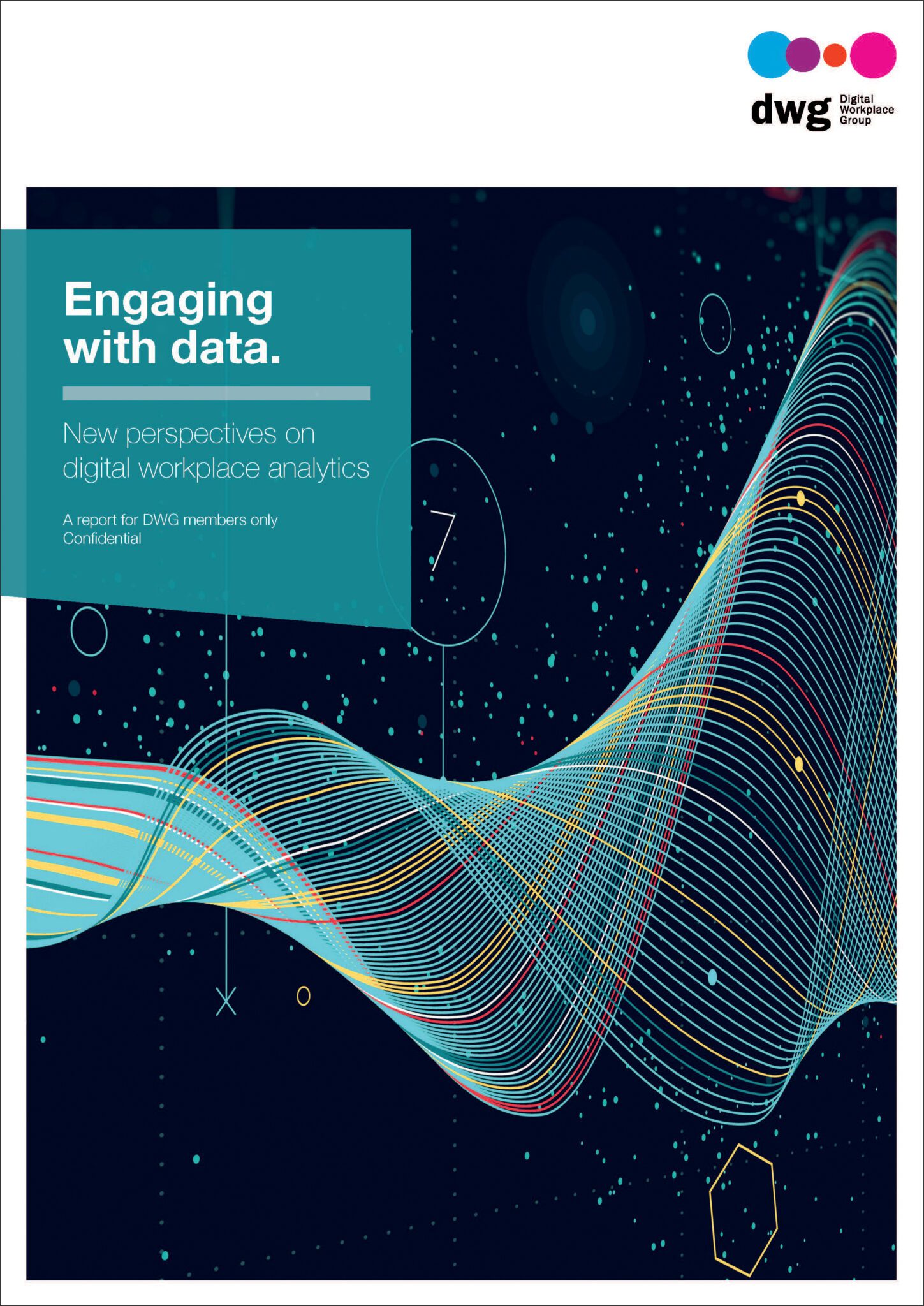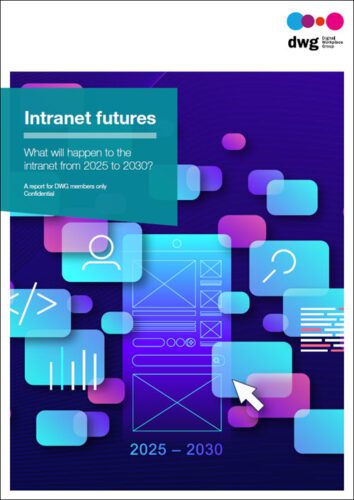Measuring up: the new strategic outlook for digital workplace metrics
By Dr David Lucas
The question of how best to deploy data and analytics (D&A) in a digital workplace setting is routinely cited as a bellwether issue by DWG members. With the global economy facing continuing inflationary and post-COVID headwinds, operational units of all kinds are under pressure to acquire decision intelligence and data literacy as an antidote to business uncertainty. At the same time, senior leaders remain hungry for evidence that their digital investments are paying off – and that opportunities for productivity and efficiency gains are not being squandered.
The sheer volume of data generated by modern workplace platforms makes the task of mining actionable perspectives especially challenging. Where once they sought guidance on what they should measure, members now complain of drowning in numbers. They also report a need to move beyond vanity metrics to ones that attract wider business attention, based on awareness of what ‘good’ looks like in analytics usage.
DWG’s latest member-only research report, Engaging with data: New perspectives on digital workplace analytics (non-members can download a free excerpt), explores the reality and promise of a new generation of D&A solutions currently gaining traction inside major workplaces. Continuing our strong topic stream on intranet, internal communication and digital workplace measurement, it looks at how tools have evolved to reflect more integrated – and geographically dispersed – user environments, and the opportunities this presents for data-led conversations with business units on improving collaboration and the overall employee experience. Case studies from The Coca-Cola Company and Avanade spotlight the pivotal role played by metrics programmes in supporting smarter-working initiatives and a ‘human-centred’ employment model.
Digital collaboration and experience are the new KPIs
Historically, digital workplace teams have faced the problem of bridging what DWG consultant Chris Tubb calls the ‘gap of causality’ between the metrics available to them and the business KPIs they hope to influence. When assessing the root causes of, say, employee churn, factors within a team’s purview (workplace flexibility, user satisfaction with tools and services, etc.) can easily be outweighed by those beyond their control, such as salary competitiveness or managerial competence. The temptation has therefore been to focus measurement on areas where these links are strongest, such as between the uptake of flexible working and a reduced office footprint. But our research suggests that this picture is evolving. In the aftermath of COVID-19, the ‘Great Resignation’ and the rise of unified communication and collaboration platforms, senior management increasingly views efficient digital workflow and a high-quality employee experience as desirable business outcomes in their own right. With sophisticated tools now available to measure these, the opportunities for meaningful dialogue with business teams seem certain to widen.
Our report highlights three areas of D&A practice where this trend is evident:
1. Workplace analytics
Techniques for evaluating teamwork and enterprise social network (ESN) activity are powerfully shaping organizational responses to the hybrid revolution, shifting attention from content consumption to patterns of interaction and engagement within teams. Pioneering analysis by Microsoft, using its own platform metrics, revealed how pandemic-era working at the firm had morphed organically to include shorter meetings, increased contact between managers and their staff, and more fragmented working days, with employees carving out time for childcare or exercise. Based on its findings, the software giant concluded that the secret to achieving impactful change in the collaborative practices of remote or hybrid teams was to address a small number of behavioural challenges, rather than reimagining the entire work culture.
The same ‘think small’ message emerges from comprehensive monitoring of collaborative behaviour by SWOOP Analytics. Having mined anonymous data from Yammer/Viva Engage, Workplace from Meta and Microsoft 365 users, it confirms that the biggest potential for improvement comes from unheroic and eminently measurable shifts in user habits. Posting in Teams or Viva Engage channels instead of sending emails or holding a meeting, for instance, would save the average employee 26 minutes a day. If organizations could replace 20% of email with channel posts, swap 50% of meeting time with asynchronous communications and cull 75% of inactive account licences over a six-month period, the benefit would be comparable to growing the workforce by 4.5%, SWOOP claims.
2. Digital employee experience monitoring
The flip side to COVID-driven investment in team-working and collaboration capability has been the added burden placed on IT teams to ensure that platforms, apps and devices used by work-anywhere populations are performing adequately. The fact that employees can be fickle in reporting the technology problems they encounter compounds this issue, making headcount planning for IT support a particular headache. For this reason, an increasingly sought-after metric of workplace effectiveness is the quality of the digital employee experience (DEX) in terms of the technology people are expected to use.
This demand has been fuelled by a boomlet in third-party tools that monitor – and in some cases diagnose and remediate – device performance issues. The most sophisticated solutions will combine real-time gathering of system, application and sentiment data with a degree of root-cause analysis, end-user engagement (announcements and nudges) and automation of basic fixes (e.g. clearing a browser cache or cleaning a hard disk).
As our report notes, impact assessments of DEX monitoring typically focus on the time and cost savings it purports to deliver. These range from support headcount reallocation and IT security efficiencies to fuzzier gains, such as improved employee productivity and retention. While take-up of full-feature solutions is at an early stage, interest is clearly growing. Gartner, for instance, predicts that 50% of IT operations will have a formal DEX strategy, team and management tool in place by 2025, compared with just 5% in 2021.
3. Sentiment analysis
There is, of course, more to the employee experience than having technology that works. With labour statistics showing a record 50.5 million people quit their jobs in the US alone last year, questions about employee commitment and satisfaction also swirl around major organizations. The problem in seeking informative answers is often one of timeliness. Conventional approaches to sentiment measurement – such as surveying the entire workforce, typically annually – are well entrenched. But in a large global employer, it is not uncommon for attitudinal survey findings to be delivered months after the fact, by which time a chunk of the people polled will be airing their grievances at another organization. This section of our report focuses instead on emerging tools that employ machine learning and related AI techniques to detect sentiment-laden content in unstructured data, such as emails and ESN posts. Software of this kind generally works by combing through text for positive, negative or neutral content; a machine-learning algorithm can be trained using tagged data to recognize sentiment-bearing words in a text source and convert these into a numerical or categorical score. Through case vignettes, the report gives examples of the capability and challenges of this approach, which has recently been adopted by popular platforms such as Viva Engage.
The remaining sections of the report examine new ways of communicating the output of D&A work to non-technical audiences and the privacy issues that must be addressed if significant hauls of workplace data are to be collected and analysed.
Download the free excerpt
Engaging with data:
New perspectives on digital workplace analytics
Get access to 100+ other best practice digital workplace reports
DWG members can access this report in full, which forms part of DWG’s best practice Research Library of 100+ reports covering key areas such as strategy and governance, personalization, user experience and change management for intranets and digital workplaces. Find out what else is in the library and new research that’s coming up. Contact us to learn how to gain access to this library via DWG Membership.
Categorised in: → Metrics and measurement, Research reports

